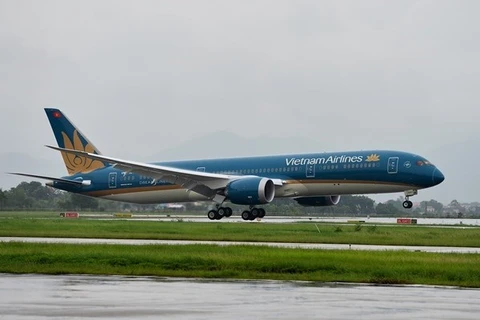Hanoi (VNA) - Supporting domestic airline firms and taking advantage of membership of the ASEAN Single Aviation Market to launch more international routes in the block and run direct flight routes from Vietnam to the United States by the national carrier Vietnam Airlines are targeted as the major goals of the transport sector’s international cooperation activities during 2016-20.
Le Tuan Anh, Head of the Ministry of Transport’s International Cooperation Department announced this at a meeting held on July 13 morning to summarise the sector’s international cooperation activities in the period of 2011-15 and set targets for 2016-20.
Anh said that the ministry planned to assist low-cost airlines to broaden their international routes both in the region and across the world by 2020.
The goals were established in the context that Vietnam has integrated deeper into the global economy than the previous period and the country is the world’s seventh fastest growing aviation market - ranked by the International Air Transport Association.
To meet increasing demand of global integration, the ministry scheduled to compile the project of aviation global integration, including sending a permanent representative of the ministry to the International Civil Aviation Organisation, he said.
Boosting the progress to build Long Thanh International Airport, which was expected to become the largest airport of Vietnam, was added to the list of goals, he said.
On international cooperation on road transport, Anh said the ministry would speed up the implementation of projects to connect transport infrastructure with neighbouring countries, encompassing China, Laos and Cambodia. For examples, with China, the project to build expressway routes of Hanoi – Lang Son, Van Don – Mong Cai, Hanoi – Cao Bang; with Cambodia – the project to construct Long Binh – Chrey Thom Bridge.
Additional road transport routes, carrying passengers and goods between Vietnam, Laos, Cambodia, China, Thailand and Myanmar would be operated during the period, he said.
Luring foreign capital investment for constructing the high-speed north-south railway was also one of the sector’s targets by 2020, he added.
2011-15 achievements
Statistics from the ministry showed Vietnam signed 24 international treaties on aviation during 2011-15 to boost domestic aviation growth.
It is estimated that over 70 international routes, connecting Vietnam to 26 countries and territories, have been run so far.
In the meantime, the revised Marine Law, adopted by the National Assembly in November 2015, was believed to be more suitable with regulations of the International Marine Organisation than before. It was hoped to take the domestic marine sector shoulder-to-shoulder with other countries.
Big seaports, heading to the East Sea, which were designed to receive ships with loading capacity of up to 50,000-100,000 DWT, had been developed, the ministry said.
During this period, a range of road routes along economic corridors between China and Vietnam, including Hai Phong – Hanoi – Kunming; Hanoi – Nanning, and Hanoi – Shenzhen, were open to public.
On international cooperation on railway transport, by sending a permanent representative to the International Unions of Railways, the country could actively participate into the union’s activities.
Challenges remain
Despite a lot of achievements, challenges have remained.
The ministry’s report, revealed on July 13, said the instability of the region has tended to increase and it affected the international cooperation among countries, including transport cooperation.
Moreover, the global economy, which had yet to fully recover from the global economic crisis, was also blamed for troubles in international transport cooperations, the ministry said.
Unfinished legal documents had caused difficulties in attracting foreign capital investment in transport infrastructure, the ministry said.
Knowledge of staff working in international transport cooperations was limited in meeting the demands of their jobs.
Dinh Viet Son, Deputy Head the Civil Aviation Authority of Vietnam, said the agency failed to help domestic airlines to expand routes to partners in France, Germany, China and Russia because the partners delayed work with the aviation industry.
Lastly, calling foreign investors to pour their money into projects of developing aviation infrastructure showed little effectiveness because it required large investment but slow capital recovery rate, he said.
Recommendations for the next period
Tuan Anh, Head of International Cooperation Department, said the ministry should provide training courses to improve the capability of staff working in transport international cooperations.
Units under the department were required to actively instruct domestic companies to seek capital investments as well as international cooperation of aviation and marine sectors among ASEAN countries. They should closely work with local authorities in enhancing projects connecting transport infrastructure among Vietnam, Laos, Cambodia and China during 2016-20, he said.
The Civil Aviation Authority of Vietnam and the Vietnam Marine Administration were told to improve the capacity of their officers before sending them to be permanent representatives in the International Marine Organisation and the International Civil Aviation Organisation if the ministry approved, he said.
Dinh Viet Son, Deputy Head the Civil Aviation Authority of Vietnam, said the agency’s units had to often propose international cooperation programmes, following cooperation agreements on civil aviation that Vietnam signed to raise the effectiveness of international cooperation in the next period.
The ministry also advised to continue its policy of encouraging foreign airlines to exploit routes in Vietnam, as well as mobilising foreign investments to develop transport infrastructure in major cities, he said.-VNA
























